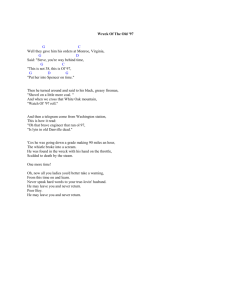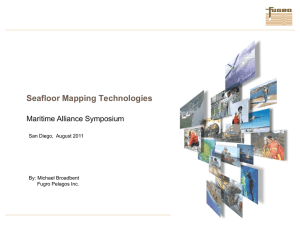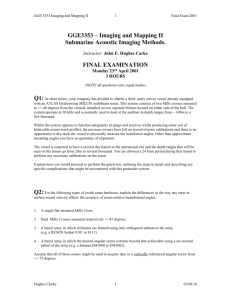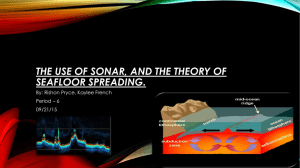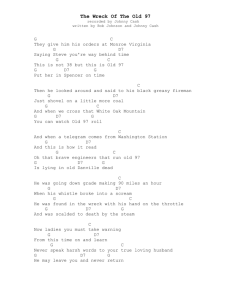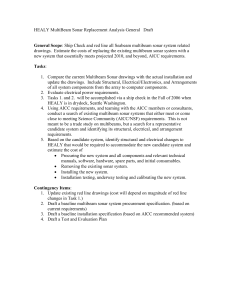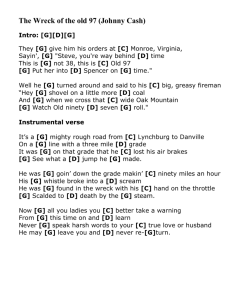GEOPHYSICAL TECHNIQUES FOR MARITIME ARCHAEOLOGICAL SURVEYS
advertisement
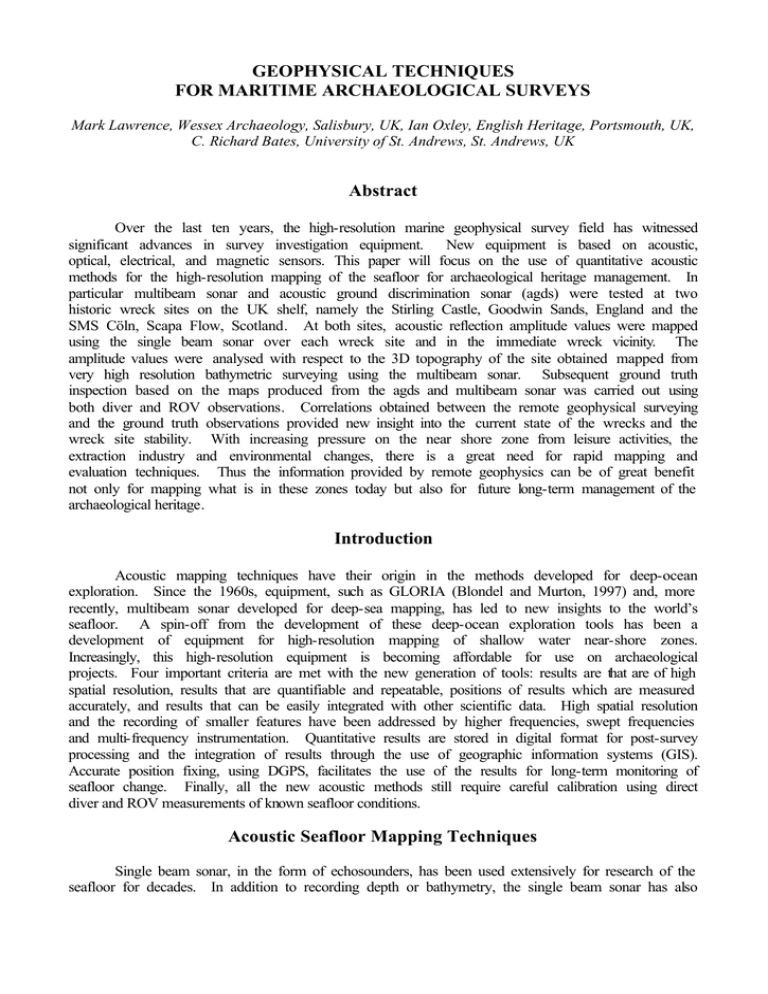
GEOPHYSICAL TECHNIQUES FOR MARITIME ARCHAEOLOGICAL SURVEYS Mark Lawrence, Wessex Archaeology, Salisbury, UK, Ian Oxley, English Heritage, Portsmouth, UK, C. Richard Bates, University of St. Andrews, St. Andrews, UK Abstract Over the last ten years, the high-resolution marine geophysical survey field has witnessed significant advances in survey investigation equipment. New equipment is based on acoustic, optical, electrical, and magnetic sensors. This paper will focus on the use of quantitative acoustic methods for the high-resolution mapping of the seafloor for archaeological heritage management. In particular multibeam sonar and acoustic ground discrimination sonar (agds) were tested at two historic wreck sites on the UK shelf, namely the Stirling Castle, Goodwin Sands, England and the SMS Cöln, Scapa Flow, Scotland. At both sites, acoustic reflection amplitude values were mapped using the single beam sonar over each wreck site and in the immediate wreck vicinity. The amplitude values were analysed with respect to the 3D topography of the site obtained mapped from very high resolution bathymetric surveying using the multibeam sonar. Subsequent ground truth inspection based on the maps produced from the agds and multibeam sonar was carried out using both diver and ROV observations. Correlations obtained between the remote geophysical surveying and the ground truth observations provided new insight into the current state of the wrecks and the wreck site stability. With increasing pressure on the near shore zone from leisure activities, the extraction industry and environmental changes, there is a great need for rapid mapping and evaluation techniques. Thus the information provided by remote geophysics can be of great benefit not only for mapping what is in these zones today but also for future long-term management of the archaeological heritage. Introduction Acoustic mapping techniques have their origin in the methods developed for deep-ocean exploration. Since the 1960s, equipment, such as GLORIA (Blondel and Murton, 1997) and, more recently, multibeam sonar developed for deep-sea mapping, has led to new insights to the world’s seafloor. A spin-off from the development of these deep-ocean exploration tools has been a development of equipment for high-resolution mapping of shallow water near-shore zones. Increasingly, this high-resolution equipment is becoming affordable for use on archaeological projects. Four important criteria are met with the new generation of tools: results are that are of high spatial resolution, results that are quantifiable and repeatable, positions of results which are measured accurately, and results that can be easily integrated with other scientific data. High spatial resolution and the recording of smaller features have been addressed by higher frequencies, swept frequencies and multi-frequency instrumentation. Quantitative results are stored in digital format for post-survey processing and the integration of results through the use of geographic information systems (GIS). Accurate position fixing, using DGPS, facilitates the use of the results for long-term monitoring of seafloor change. Finally, all the new acoustic methods still require careful calibration using direct diver and ROV measurements of known seafloor conditions. Acoustic Seafloor Mapping Techniques Single beam sonar, in the form of echosounders, has been used extensively for research of the seafloor for decades. In addition to recording depth or bathymetry, the single beam sonar has also been recently used, together with acoustic ground discrimination sonar (AGDS), to quantify the strength of acoustic return from the seafloor, thus discriminating seafloor types (Bates and Whitehead, 2001). An AGDS makes use of the fact that different seafloor types will scatter and absorb different amounts of acoustic energy. Thus, a measure of the strength of return from the seafloor can be used to class different reflection types through calibration with direct sampling. The strength of the first return echo is typically known as E1, and the strength of the first multiple echo (second return) is known as E2. E1 has been attributed to the “roughness” of the seafloor and E2 with the “hardness” (Chivers et al., 1990). Sidescan sonar has established itself as the predominant tool for imaging the ocean floor, giving good object detection and seafloor character discrimination (Blondel and Murton, 1997). This “side-looking” sonar is typically towed close to the seafloor and measures a swath from which it is possible to produce a near 100% mosaic picture of the seafloor. For high-resolution surveying, transducer frequencies typically range between 100kHz and 700kHz, and modern systems are capable of resolving objects of 20cm or less. The final products are images showing different reflection strengths or amplitude characteristics that can be mapped into geo-referenced seafloor charts. Bathymetric sidescan is an extension of high-resolution digital sidescan systems. It not only enables a quantified picture of the seafloor to be produced, similar to a sidescan image; but, through the use of multiple transducers, a simultaneous record of the bathymetry is also recorded. Transducers are typically hull mounted, and the method has found widespread application for mapping large swaths of gently undulating seafloor as the width of survey is approximately seven times the depth of water to the transducers (Bates and Byham, 2001). Multibeam sonar uses a combination of hardware and software control of multiple transducers to produce a number of sonar signals, or beams, that propagate from the sonar head in a fan, thus recording bathymetry and amplitude measurements similar to the bathymetric sidescan (Keeton and Searle, 1996). Most multibeam systems are hull mounted and have coverage of similar swath widths to the bathymetric sidescan. Typical high-resolution systems operate at frequencies of up to 450kHz, giving object discrimination of 10cm. Case Histories Two examples are given of the use of integrated acoustic methods in marine archaeology. The first example uses AGDS and sidescan sonar to record changes in the dynamic conditions at a wreck on the Goodwin Sands (Kent, England). The second example is from a survey using multibeam sonar, together with AGDS, to map and manage the wreck site containing the scuttled German High Seas Fleet in Scapa Flow (Orkney, Scotland). The Stirling Castle The Stirling Castle was a 70-gun ship of the line built in 1678 at Deptford, UK, as part of Samuel Pepy’s regeneration of the Navy and was lost with her crew on the Goodwin Sands in the Great Gale of 1703. Local sport divers found the wreck in 1979 when the site was dramatically exposed by local erosion of surrounding fine, non-cohesive sand. The site of the Stirling Castle is a Designated Wreck Site protected under The Protection of Wrecks Act of 1973. The Goodwin Sands is a series of banks off the East Kent coast that dry at low water and change shape on a seasonal basis (Cloet, 1954). The exposed structure shows no evidence of weed growth and a lack of mussels, or other colonising organisms, indicates that the wreck has been almost totally covered by sand until recently. The ECHOplus AGDS system (SEA Ltd.) was used with a dual frequency Furuno Echosounder to record closely spaced survey lines across the wreck site and adjacent seafloor after a high frequency sidescan sonar survey was made of the site. The strength of the first return echo E1 (roughness) was found to increase significantly over the wreck site. It is postulated that the increase in value is correlated with higher backscatter due to the upstanding, disseminated wreck material. The value of E2 (hardness) was noted to decrease over the wreck site. It is suggested that this could be due to the presence of waterlogged wood and finegrained sediment material trapped within the remains of the wreck structure. A density plot of the AGDS E1 values plotted against E2 values is shown in Figure 1a. Two statistically distinct clusters of E1-E2 with values greater than 1 standard deviation from the site mean are apparent within the area of survey. The smaller cluster in Figure 1a represents those E1-E2 values that are associated with the area of the wreck site. These values are highlighted where the E1-E2 values, which make up this cluster, are re-plotted on the geo-referenced sidescan image in Figure 1b. The association with the wreck area is clear. In summary, a discrete cluster of E1-E2 values, quite separate from the majority of E1-E2 values that represent the surrounding sediments, appears to define the Stirling Castle wreck site. This information has formed the basis of yearly monitoring of changes in condition at the site as the sands migrate and the wreck is further degraded. Scapa Flow The remains of the scuttled German High Seas Fleet in Scapa Flow represent a significant archaeological and historical resource, forming a unique underwater record of one of the great periods of British and German maritime history. At the conclusion of World War I, over 70 warships of the German High Seas Fleet were interned by the Allies only to be dramatically scuttled by their crews on 21st June 1919. Today, seven wrecks of major warships remain at the site and they have been designated Scheduled Ancient Monuments under the Ancient Monuments and Archaeological Areas Act of 1979. Historic Scotland, who manage the site, have a number of particular challenges in promoting an integrated approach to the future care and protection of the site (Historic Scotland, 1999). Key components of historical shipwreck management include the premise that good data are a pre-requisite for good decision-making, developing an understanding of the site's environment through the implementation of comprehensive baseline surveys followed by the identification and tracking of processes of change (Oxley, 2001). A multi-disciplinary initiative, ScapaMAP (the Scapa Flow Maritime Archaeological Project: Oxley, 2002), initiated an integrated baseline geophysical survey of the site in 2001, which included the use of multibeam sonar (Reson SeaBat 8125) and AGDS (ECHOplus). Preliminary data modelling was accomplished using Terramodel, CARIS, and visualisation in Fledermaus and GeoZui. An example of the high-resolution images, which will be critical to future site management, is given in Figure 2. In this figure, the light cruiser, SMS Cöln, can be seen lying in about 35m of water on its starboard side with extensive, post-scuttling salvage damage clearly visible on the upturned hull. Also shown, draped over the hull and seafloor in this figure, are the E1 reflection strength results for the Echoplus AGDS survey. Increasing reflection strength is indicated in the figure by the increasing size of the circles. High correlation was obtained between the strength of reflection and the wreck material (nature and geometry with respect to the sonar signal). Therefore, the highest strength returns are seen where the smooth hull is orientated perpendicular to the incident sonar wave. Conclusions: Future for Maritime Archaeological Investigations High-resolution geophysics is finding increasing use in surveying for, and the management of, submerged archaeological heritage sites. In particular, modern techniques that yield quantitative, and thus repeatable, information mean that conditions on sites can be monitored and compared on a periodic basis. This is an important ability for the long-term management of sites that are currently known, and for the future assessment of sites that will no doubt continue to be found as climate changes and increased leisure activity puts pressure on the near-shore zone. The examples given here illustrate the use of techniques that do not penetrate the surface. However, in many sites, subsurface investigation tools are contributing significant additional information. The future of archaeological surveys, therefore, will contain a range of remote geophysical technologies to compliment the direct observation methods by diver and remotely operated vehicles. References Bates, C.R., Byham, P., 2001, Swath-sounding techniques for near shore surveying, Hydrographic Journal, 100, pp.13-18. Bates, C.R., Whitehead, J., 2001, Echoplus measurements in Hopavagen Bay, Norway, Sea Technology, 42, 6, pp.34-43. Blondle, P., Murton, B.J., 1997, Handbook of Seafloor Sonar Imagery, Wiley, New York, 314p. Cloet, R.L., 1954, Hydrographic Analysis of the Goodwin Sands and the Brake Bank, Geographical Journal, CXX, part 2. Historic Scotland, 1999, Conserving the underwater heritage: operational policy, Paper HP6, Historic Scotland, Edinburgh, UK. Keeton, K.A., Searle, R.C., 1996, Analysis of Simrad EM12 multibeam bathymetry and acoustic backscatter for seafloor mapping, Marine Geophysics Researches, 19, pp.63-688. Oxley, I., 2001, Towards the integrated management of Scotland's cultural heritage: examining historic shipwrecks as marine environmental resources, World Archaeology, 32, 3, pp.413-426. Oxley, I., 2002, Scapa Flow and the protection and management of Scotland’s historic military shipwrecks, Antiquity, 76, 293, pp.862-868. Figure 1a.: Density plot of all E1/E2 values for the Stirling Castle site; 1b.: sidescan sonar record with overlay of E1/E2 cluster highlighted in Figure 1a. Figure 2.: Multibeam image of SMS Cöln with draped AGDS E1 value.
